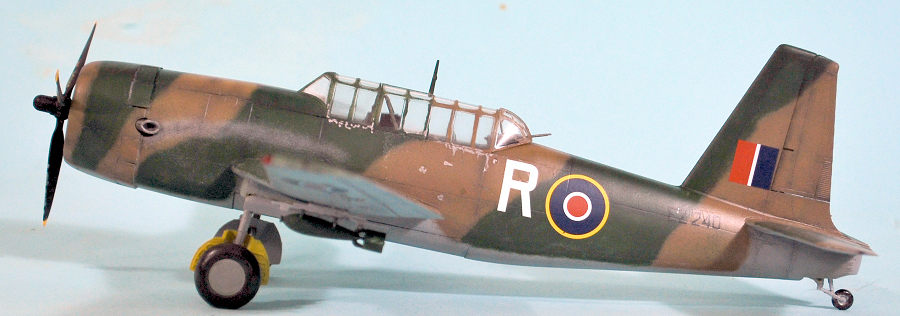
| KIT #: | DW 48044 |
| PRICE: | $55.00 |
| DECALS: | Four options |
| REVIEWER: | Tom Cleaver |
| NOTES: |

| HISTORY |
The V-72 Vengeance dive-bomber was developed independently by Vultee Aircraft Co. for France. A French purchasing commission led by Col Paul Jacquin contracted with Vultee, based on their experience with the V-11 family of attack bombers. The V-72 was a large two-seat aircraft powered by the Wright R-2600 Cyclone. France ordered 300 but fell before any were delivered.
After the collapse of France, and due to pressure from Lord Beaverbrook, the UK’s Ministry of Aircraft Production bypassed RAF requirements, taking over and extending French orders for the V-72.
The first V-72, first flew in July 1941, rather than at the end of March as often stated. There was no prototype and few changes were needed. The distinctive wing planform was the result of a miscalculation in the center of gravity, with the inner wing extended forward to deal with this, while the outer wings were given dihedral to increase stability. The wing had zero incidence, which allowed for good aim in a dive, but also resulted in the airplane flying in a significant nose-up in level flight which hindered pilot visibility.
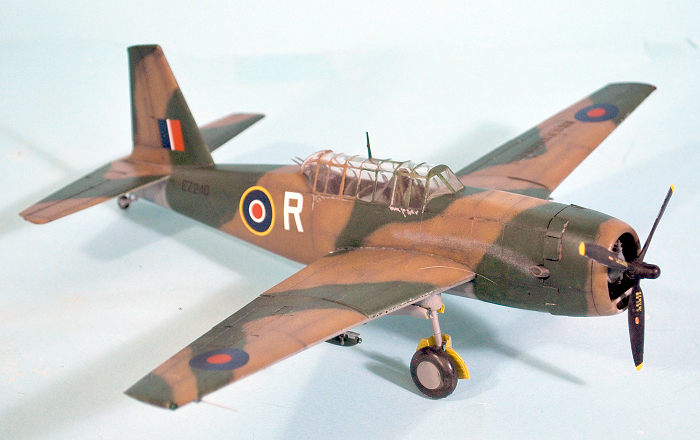 The V-72 was
named Vengeance by Vultee, not by the British. Britain placed orders for 200
from Vultee, to be built in a new factory in Nashville, Tennessee, and another
200 from Northrop Aircraft in Hawthorne, California. Due to minor equipment and
servicing differences, confusingly, the Vultee machines were designated Mk.II
and the Northrop examples as Mk.I. The first Northrop-built Vengeance flew
November 30, 1941.
The V-72 was
named Vengeance by Vultee, not by the British. Britain placed orders for 200
from Vultee, to be built in a new factory in Nashville, Tennessee, and another
200 from Northrop Aircraft in Hawthorne, California. Due to minor equipment and
servicing differences, confusingly, the Vultee machines were designated Mk.II
and the Northrop examples as Mk.I. The first Northrop-built Vengeance flew
November 30, 1941.
A US order for 200 was placed as part of the new Lend-Lease arrangement for British use, designated as the Mk.Ia or A-31-NO by Northrop). Vultee-built aircraft in a second run under Lend-Lease were designated as Mk.III, or A-31-VN. Production was slow, with only 12 aircraft having been accepted as of March 10, 1942.
Northrop completed production in November 1943, with the last from Vultee in May 1944. In July 1943, Maj Gen Davenport Johnson, the AAF’s director of military requirements, declared the A-31 to be “a shining example of the waste of material, man-power, and time in the production of an airplane which this office has tried to eliminate for several months." In service, the Vengeance was a good dive-bomber - but senior officers didn't want to use it.
The first RAF squadrons, 82 and 110 Squadrons, replaced their Blenheims with Vengeances in October 1942. Both stationed at Cholavararn, Madras Presidency, they undertook anti-submarine patrols over the Bay of Bengal until being deployed to front-line duties. Slow deliveries initially limited each unit to eight aircraft while they worked up at Quetta, Balochistan and Cholavararn.
After training, an average pilot in a vertical dive could drop two internally carried 5001b and two wing-mounted 2501b bombs within 250 yards; in operations, this improved to a CEP of 25 yards, close enough to give really close support to ground troops. Unlike a fighter-bomber, bombs dropped in this manner had sufficient penetration to blast any deep bunker.
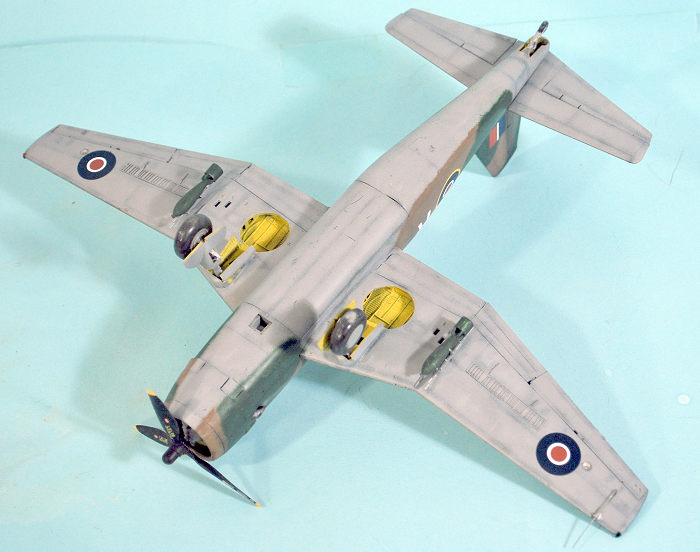 110 Squadron’s
first mission was flown on March 19, 1943 against a Japanese headquarters at
Htizwe, Burma. 45 and 82 Squadrons joined 110 Squadron in March 1943 as 168
Wing, developing close support techniques with the army.
110 Squadron’s
first mission was flown on March 19, 1943 against a Japanese headquarters at
Htizwe, Burma. 45 and 82 Squadrons joined 110 Squadron in March 1943 as 168
Wing, developing close support techniques with the army.
Vengeances were heavily deployed in support of the second Arakan campaign during 1943-44. Formations of 12 “VDBs” — the nickname used locally by the units for “Vengeance dive-bombers” — attacked Japanese strongpoints from October 1943 onwards, escorted by Hawker Hurricanes.
The 2501b and 5001b general-purpose bombs were augmented by 5001b NITI (nose instantaneous, tail instantaneous) bombs fitted with an extension rod for maximum above-ground blast and fragmentation in the jungle. Vengeances also acted as pathfinders for Wellingtons dropping 4,0001b high-explosive bombs.
On the Arakan front 82 Squadron operated with 8 Squadron Indian Air Force. Compared with B-24s that achieved 50 per cent hits and B-25s that scored 70 per cent, the Vengeances consistently scored 100 per cent in attacks on Japanese bunkers.
Australia ordered Brewster Bermudas and Curtiss A-25 Shrikes, but in an agreement with the British in October 1941 the RAAF took over 297 Vengeances from RAF orders instead. In May 1942 the first five were erected at Bankstown, New South Wales, assisted by Vultee staff, but desperate pleas for more went unfulfilled as the Americans diverted production to their own needs. Further examples did not arrive until April 1943, when the immediate threat of invasion had passed.
In August 1943, General George Kenney, commander of the Allied Air Forces in the South-West Pacific, requested a squadron of dive-bombers for use against pinpoint targets in the Huon Gulf area. The semi-trained No 24 Squadron was rushed to Dobodura without the normal infrastructure as it was expected to be a brief deployment. They arrived on September 2 and flew their debut combat mission on September 7, complicated by bad weather and difficulty finding their base. On September 18, 14 Vengeances joined a strike on Finschhafen to assist a landing by the Australian Army, and during September and October the type played a significant role in halting a major Japanese counterattack. However, operations were limited by equipment shortages. Some issues were due to the crews having only partly trained in non-tropical southern Australia. Finally, in December, the squadron operated against Japanese positions on New Britain and New Ireland ahead of the American landings in western New Britain.
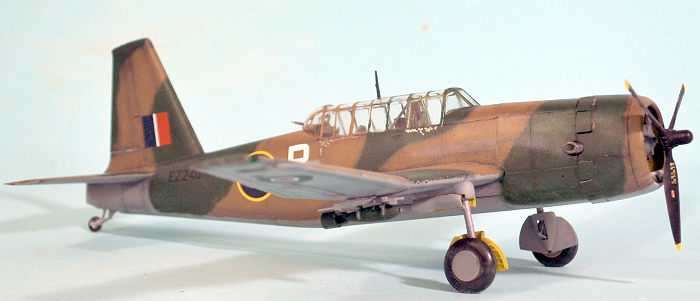 No 10
Operational Group was created around the Vengeance-equipped attack component of
77 Wing to act as a mobile strike force supporting Allied ground units advancing
on the Japanese. The wing consisted of three squadrons: 21, 23 and 24, with
Vengeances, escorted by 78 Wing’s Kittyhawks. 24 Squadron made its first strike
on January 17, 1944, the two other units joining battle on February 18.
No 10
Operational Group was created around the Vengeance-equipped attack component of
77 Wing to act as a mobile strike force supporting Allied ground units advancing
on the Japanese. The wing consisted of three squadrons: 21, 23 and 24, with
Vengeances, escorted by 78 Wing’s Kittyhawks. 24 Squadron made its first strike
on January 17, 1944, the two other units joining battle on February 18.
On February 19, 24 Squadron bombed the Japanese at Hansa Bay. This long-range operation required a refueling stop at Dumpu, a challenging prospect as each Vengeance was fully loaded with two 500lb bombs and two 250lb anti-personnel bombs. A major effort began on February 26 with 36 Vengeances — 12 from each squadron — attacking the airstrips at Alexishafen and Madang. The raids were repeated on the 28th with 33 Vengeances. After a break of a few days while they bombed Japanese retreat routes, the airstrips were again heavily attacked, and on March 8 they joined a combined operation against a Japanese camp 10 miles north of Alexishafen. After the landings at Hollandia, it was found the air effort had completely neutralized the Japanese bases there, with 500 Japanese aircraft destroyed on the ground.
Despite this success — and to the crews’ surprise — the Vengeance squadrons were withdrawn at the end of March on the orders of MacArthur, after only 15 days operating in New Guinea. Eventually they were replaced in combat by RAAF Beaufighter, Boston and Beaufort squadrons.
Ultimately, as with the RAF and Indian Air Force, Australia’s use of the Vengeance was never regarded by high command as more than an unwanted experiment, despite valiant work by the crews. It is notable that other types including obsolete Commonwealth Wirraways were instead in limited dive-bombing use to the war’s end. The RAAF Vengeance squadrons were re-equipped with Liberators.
| THE KIT |
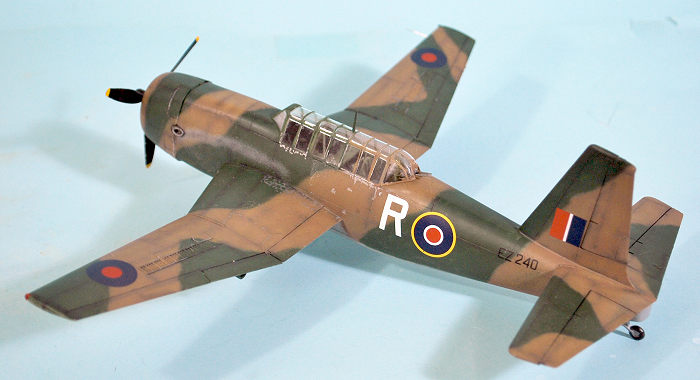 This Dora Wings
Vengeance is the second to appear in 1/48, the first released several years ago
by AZ Models. This kit is incomparably better than the earlier one, being fully
accurate as well as being a better-designed kit. It comes in Dora Wings’ tan
plastic, with little if any flash. The kit is released as an RAAF Vengeance,
with markings for the four squadrons that operated the type. The clear plastic
canopy, which can only be assembled in the closed position, is very clear
(interestingly, the aerodynamics of the Vengeance were such it was mostly flown
with the canopies closed). Each example has interesting nose art.
This Dora Wings
Vengeance is the second to appear in 1/48, the first released several years ago
by AZ Models. This kit is incomparably better than the earlier one, being fully
accurate as well as being a better-designed kit. It comes in Dora Wings’ tan
plastic, with little if any flash. The kit is released as an RAAF Vengeance,
with markings for the four squadrons that operated the type. The clear plastic
canopy, which can only be assembled in the closed position, is very clear
(interestingly, the aerodynamics of the Vengeance were such it was mostly flown
with the canopies closed). Each example has interesting nose art.
One mistake is that the two machine guns supplied for the rear cockpit are .50-caliber rather than .30 caliber which was right for the Vengeance I and II.
| CONSTRUCTION |
After watching another kit being assembled over at iModeler, I opted for a different method of construction. I first assembled the wings. These are designed to have the flaps lowered, but they can be assembled “up” if the attachment points on the flaps are removed. I had thought to do the dive brakes extended, but when I saw how fragile the photoetch parts were, I opted to attach them closed, which was not hard.
The kit does not have a carry-through spar. However, if you assemble the wings to the relevant fuselge half before further fuselage assembly, you can get perfect fit without any filler needed. The wing is a solid assembly done this way. When I broke the horizontal stabilizer at the center point, I decided to attach those parts at this time also, which turned out to be a good idea since I was also able to get solid fit.
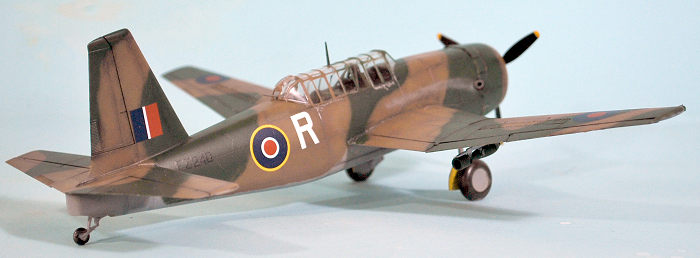 The control
surfaces all have the now-standard Dora Wings molding of one half fitting inside
the other in order to get a thin trailing edge, with a resulting seam that has
to be filled and sanded smooth. Other than that, all the control surfaces fit
easily in position.
The control
surfaces all have the now-standard Dora Wings molding of one half fitting inside
the other in order to get a thin trailing edge, with a resulting seam that has
to be filled and sanded smooth. Other than that, all the control surfaces fit
easily in position.
I moved on to the cockpit, and assembled the cockpit and bomb bay before painting them. At this point I was going to have the bomb bay open, but after checking the attachment for the open doors, and the fact that the doors-closed part fit perfectly, I decided to go with the bomb bay closed up. I used Eduard seatbelts in the cockpit because I had them and they looked better than the kit’s seatbelts.
The tailwheel assembly has to be done and installed before closing up the fuselage. Given its position at the extreme tail, I was sure it would be later broken and I was unsurprised when that happened. I managed to get the broken parts back in position, but the only solution here is to handle the rear fuselage with extreme caution once assembled.
The fuselage went together easily, though I did need to use Mr. Surface 500 on the centerline seams. The engine was painted and assembled, and the engine cowling was also assembled. Again, I had a notable lack of success with the photo-etch cowling flaps and replaced those with flaps made from .010 Evergreen sheet.
| COLORS & MARKINGS |
Vengeance was painted with US Lend-Lease colors: DuPont “flat Earth, which
is a bit more yellow than the RAF official color, with US Medium Green in
place of RAF Dark Green. (This might also have been US green-base OD-41,
which is the same color as RAF Dark Green, the two colors both being based
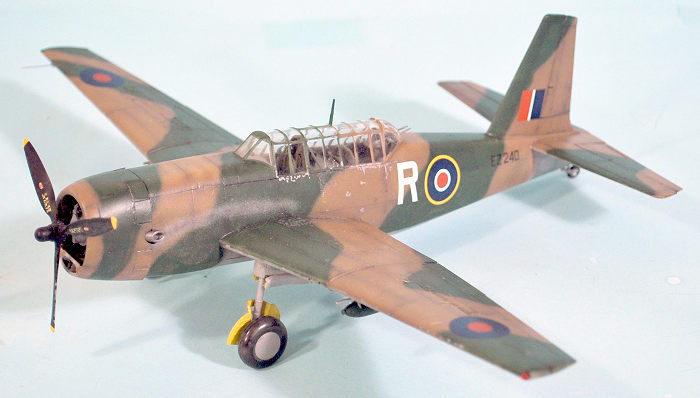 on the
specifications for World War I “PC 10"). The lower surfaces were painted
light grey. I did this with my “home-brew” Tamiya mix for US Dark Earth,
based on Tamiya “Flat Earth” and “Khaki Drab,” and Tamiya “Deep Green” for
the US Medium Green, and Tamiya “Sky Grey” for the light grey. Each color
was “post shaded” to simulate sun fading.
on the
specifications for World War I “PC 10"). The lower surfaces were painted
light grey. I did this with my “home-brew” Tamiya mix for US Dark Earth,
based on Tamiya “Flat Earth” and “Khaki Drab,” and Tamiya “Deep Green” for
the US Medium Green, and Tamiya “Sky Grey” for the light grey. Each color
was “post shaded” to simulate sun fading.
As research, I had bought Peter Smith’s “The Vultee Vengeance In Battle,” which is an excellent history of the type’s use in the Burma campaign. I decided in the interests of “being different” to do a Vengeance as marked in 1943, with the standard RAF insignia with red colors, as an airplane of 110 Squadron. This was done with decals from the dungeon.
I applied some exhaust staining and “dings” on the airframe. I decided to arm the model with 250-lb bombs, using RAF bombs and racks from an Airfix Blenheim kit that I am not going to do with the bomb bay open. I attached the landing gear and prop and declared the project finished.
| CONCLUSIONS |
The Vengeance will never be mistaken for anything else due to the unique airframe design. Modelers have long asked for a Vengeance in 1/48 scale and Dora Wings has delivered. I ordered mine shortly after the outbreak of the war in Ukraine, but it was delivered at the beginning of August. In the meantime, I had also gotten a kit from eBay. I plan to do the second out OOB with the RAAF markings.
For those who have wanted a Vengeance in their collection, this is the kit you have waited for. Recommended for those with experience in limited-run kits.
18 August 2022 Copyright
ModelingMadness.com. All rights reserved. No reproduction in part or in whole
without express permission. Review kit courtesy of Dora Wings. If you would like your product reviewed fairly and fairly quickly, please
contact
the editor or see other details in the
Note to
Contributors.